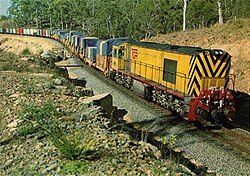Launceston & Western Railway
The early railways of Tasmania were constructed by a number of private companies, rather than owned by the Government.
Proposals were considered by the Tasmanian Government for the construction of a railway from Hobart to Launceston as early as 1856, when the colony gained responsible government.
In June 1857, railway committees were formed in Deloraine, Carrick, Longford, Perth and Westbury, to lobby for the construction of a railway between Launceston and Deloraine. [2] Delegations from these committees were successful in lobbying the Mayor of Launceston to organise a meeting on the issue on 27 August, with discussions around the need for a railway to assist farmers in getting produce to market, given the poor state of roads and the cost of transporting goods. Subsequently, a petition was organised to deliver to the Governor. [3] [4]
In 1858, a Parliamentary Joint Committee reported in favour of railway construction within the Colony, but nothing was done until 1865 when the Prospectus of the Launceston and Western Railway Company was issued. The first Railway Act was passed later that year which provided for the construction of a railway between Launceston and Deloraine by private enterprise. [5] [6] [7] [8]
The Launceston and Western Railway was a Joint Stock Company of £450,000 capital, chiefly borrowed in England, with the interest guaranteed by the Tasmanian Government. The land-holders, whom the line would benefit, entered into an obligation to recoup the State should the returns from the railway fall short of the interest money. [9]
The Launceston and Western Railway was formed on 9 May 1867. Surveying of the line begun almost immediately, with pegs being laid as far as Perth by July 1867. [10] The first sod of the line was turned on 15 January 1868 by the Duke of Edinburgh who was on a visit to the Colonies.
On 15 July 1868 tenders were opened for the construction of the railway. Shareholders criticised the tenders for being unfair to local firms, preferring those from the other colonies rather than Tasmania. [11] The contracts were awarded to Melbourne-based Overend and Robb, who had worked on railways in Victoria.
In August 1868, construction started at Jingler's Valley near Young Town. The undulating country presented few engineering challenges, with the only major works being a bridge over the North Esk in Launceston, cuttings and embankments climbing from St Leonards to Western Junction, a brick viaduct at Perth, and the Longford Railway Bridge. [12]
Steam transport began earnestly in June 1869, when the contractors began hauling ballast from a quarry in Invermay. On 19 August 1869, the first "ride-on-rails" excursion took place between Jingler's Valley and Launceston, giving residents their first experiences with train travel. [12]
By February 1870, most of the permanent way was complete, except for areas around Westbury and the Longford bridge. New tenders were issued for the construction of station buildings, while further carriages and rolling stock were being fabricated. [13] The date for completion as set out in the contract was 10 March 1870, but an extension was given and construction continued to a point where the opening date could be set for the following September.
In July 1870, the first appointments of stationmasters and staff were made, and sidings had been completed at Perth, Longford and Westbury. Stations at Launceston, Longford, Westbury, Deloraine, and other stops were being built at this time, and the final shipment of rails from England meant completion of the line was expected by mid-August. [14]
Extensive rains resulted in further delays, with flooding in parts requiring the construction of culverts and extra drainage, and it was not until 10 February 1871 that the line was opened for traffic by the Governor. When the line was opened, a service of three double-headed trains each way per day was operated, but this proved unsatisfactory and later on one locomotive per run was used.
During the construction period, the company had experienced some difficulty in raising the necessary finance to meet the cost of construction. It applied to the Government for assistance. The Government appointed two Railway Commissioners to generally supervise all railway construction and advance the company the finance to complete the building of the line. The construction contractor continued to operate the railway until November 1871, the L&WR then took over. [5]
By December 1872, it was agreed that a fifth locomotive was required and an order was placed with Sharp, Stewart and Company. Traffic showed an increase after the company took over the working of the line, however difficulties were experienced in continuing operations and the payment of interest on loans.





